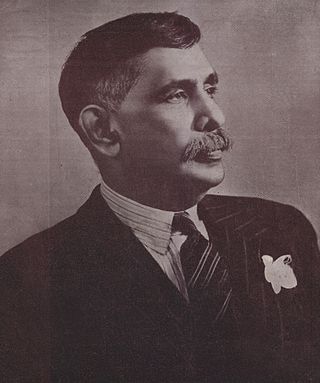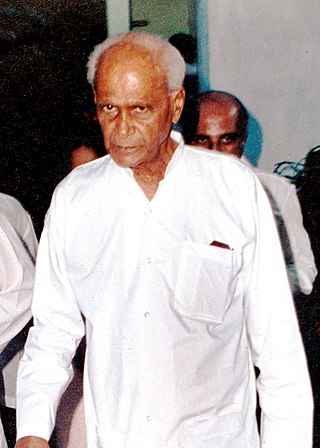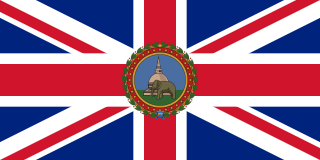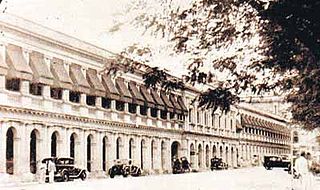| This article is part of a series on the |
| Politics of Sri Lanka |
|---|
 |
|
|
|
|
|
This is a list of cabinets of Sri Lanka since 1947.
| This article is part of a series on the |
| Politics of Sri Lanka |
|---|
 |
This is a list of cabinets of Sri Lanka since 1947.
The Executive Council of Ceylon was the Executive Council created in British Ceylon by the British colonial administration on the recommendations of the Colebrooke-Cameron Commission along with the Legislative Council of Ceylon on March 13, 1833.
At its creation the Executive Council was headed by the Governor, along with five members appointed by the Governor. These five members were officials who held the posts of the Colonial Secretary, the Attorney General, the Auditor-General, the Treasurer and the General Officer Commanding, Ceylon. The Council exercised executive power and advised the governor. As a result of the First Manning Reforms three non-officials were elected to the executive council.
With enactment of the new constitution of the Dominion of Ceylon in 1947 the Executive Council was replaced by a National Cabinet.
| # | Cabinet | Took office | Left office | Head of state | Head of government | Governing party | |
|---|---|---|---|---|---|---|---|
| 1 | D. S. Senanayake cabinet | 24 September 1947 | 22 March 1952 | George VI (1947–1952) | D. S. Senanayake | United National Party | |
| 2 | Dudley Senanayake cabinet I | 22 March 1952 | 12 October 1953 | Elizabeth II (1952–1972) | Dudley Senanayake | ||
| 3 | Kotelawala cabinet | 12 October 1953 | 12 April 1956 | John Kotelawala | |||
| 4 | S. W. R. D. Bandaranaike cabinet | 12 April 1956 | 26 September 1959 | S. W. R. D. Bandaranaike | Sri Lanka Freedom Party | ||
| 5 | Dahanayake cabinet | 26 September 1959 | 20 March 1960 | Wijeyananda Dahanayake | |||
| 6 | Dudley Senanayake cabinet II | 21 March 1960 | 21 July 1960 | Dudley Senanayake | United National Party | ||
| 7 | Sirimavo Bandaranaike cabinet I | 21 July 1960 | 25 March 1965 | Sirimavo Bandaranaike | Sri Lanka Freedom Party | ||
| 8 | Dudley Senanayake cabinet III | 25 March 1965 | 29 May 1970 | Dudley Senanayake | United National Party | ||
| 9 | Sirimavo Bandaranaike cabinet II | 29 May 1970 | 23 July 1977 | Sirimavo Bandaranaike | Sri Lanka Freedom Party | ||
| 10 | Jayewardene cabinet I | 23 July 1977 | 7 September 1978 | William Gopallawa (1972–1978) | J. R. Jayewardene | United National Party | |
| 11 | Jayewardene cabinet II | 7 September 1978 | 1980 | J. R. Jayewardene | |||
| 12 | Jayewardene cabinet III | 1980 | 1988 | ||||
| 13 | Jayewardene cabinet IV | 1988 | 2 January 1989 | ||||
| 14 | Premadasa cabinet I | 2 January 1989 | 1990 | Ranasinghe Premadasa | |||
| 15 | Premadasa cabinet II | 1990 | 1 May 1993 | ||||
| 16 | Wijetunga cabinet I | 1 May 1993 | 19 August 1994 | Dingiri Banda Wijetunga | |||
| 17 | Wijetunga cabinet II | 19 August 1994 | 12 November 1994 | SLFP led People's Alliance | |||
| 18 | Kumaratunga cabinet I | 12 November 1994 | 18 October 2000 | Chandrika Kumaratunga | |||
| 19 | Kumaratunga cabinet II | 18 October 2000 | 7 December 2001 | ||||
| 20 | Kumaratunga cabinet III | 12 December 2001 | 2 April 2004 | UNP led United National Front | |||
| 21 | Kumaratunga cabinet IV | 2 April 2004 | 19 November 2005 | SLFP led United People's Freedom Alliance | |||
| 22 | M. Rajapaksa cabinet I | 19 November 2005 | 28 January 2007 | Mahinda Rajapaksa | |||
| 23 | M. Rajapaksa cabinet II | 28 January 2007 | 23 April 2010 | ||||
| 24 | M. Rajapaksa cabinet III | 23 April 2010 | 28 January 2013 | ||||
| 25 | M. Rajapaksa cabinet IV | 28 January 2013 | 9 January 2015 | ||||
| 26 | Sirisena cabinet I | 12 January 2015 | 17 August 2015 | Maithripala Sirisena | UNP led United National Front for Good Governance | ||
| 27 | Sirisena cabinet II | 24 August 2015 | 26 October 2018 | ||||
| 28 | Sirisena cabinet III | 29 October 2018 | 15 December 2018 | SLFP–SLPP led coalition | |||
| 29 | Sirisena cabinet IV | 20 December 2018 | 21 November 2019 | UNP led United National Front for Good Governance | |||
| 30 | G. Rajapaksa cabinet I | 21 November 2019 | 12 August 2020 | Gotabaya Rajapaksa | SLPP led Sri Lanka People's Freedom Alliance | ||
| 31 | G. Rajapaksa cabinet II | 12 August 2020 | 3 April 2022 | ||||
| 32 | G. Rajapaksa cabinet III | 18 April 2022 | 9 May 2022 | ||||
| 33 | G. Rajapaksa cabinet IV | 12 May 2022 | 14 July 2022 | SLPP–UNP led coalition | |||
| 34 | Wickremesinghe cabinet | 22 July 2022 | 23 September 2024 | Ranil Wickremesinghe | |||
| 35 | Dissanayake cabinet I | 24 September 2024 | 18 November 2024 | Anura Kumara Dissanayake | JVP led National People's Power | ||
| 36 | Dissanayake cabinet II | 18 November 2024 | Incumbent | ||||

The Parliament of the Democratic Socialist Republic of Sri Lanka is the supreme legislative body of Sri Lanka. It alone possesses legislative supremacy and thereby ultimate power over all other political bodies in the island. It is modeled after the British Parliament. The 17th Parliament of Sri Lanka will convened on 21 November 2024.

Don Stephen Senanayake was a Ceylonese statesman. He was the first Prime Minister of Ceylon having emerged as the leader of the Sri Lankan independence movement that led to the establishment of self-rule in Ceylon. He is considered as the "Father of the Nation".

Solomon West Ridgeway Dias Bandaranaike, also known as "The Silver Bell of Asia", was a Ceylonese statesman who served as the fourth Prime Minister of the Dominion of Ceylon, serving from 1956 until his assassination. The founder of the left-wing and Sinhalese nationalist Sri Lanka Freedom Party, his tenure saw the country's first left-wing reforms.

The governor-general of Ceylon was the representative of the Ceylonese monarch in the Dominion of Ceylon from the country's independence in 1948 until it became the republic of Sri Lanka in 1972.

Wijeyananda Dahanayake was a Sri Lankan politician. He was the Prime Minister of Ceylon from September 1959 to March 1960.

Dudley Shelton Senanayake, was a Sri Lankan statesman who served as Prime Minister of Ceylon from 1952 to 1953, in 1960, and from 1965 to 1970 and Leader of the Opposition from 1960 to 1964. Senanayake's tenures as prime minister were associated with democratic policies focused on agricultural and educational reforms with a pro-western alignment.

Sir Oliver Ernest Goonetilleke was a Sri Lankan statesman. Having served as an important figure in the gradual independence of Ceylon from Britain, he became the third Governor-General of Ceylon (1954–1962). He was the first Ceylonese individual to hold the vice-regal post.

The Constitution of the Democratic Socialist Republic of Sri Lanka has been the constitution of the island nation of Sri Lanka since its original promulgation by the National State Assembly on 7 September 1978. As of October 2022 it has been formally amended 21 times.

The governor of Ceylon was the representative in Ceylon of the British Crown from 1795 to 1948. In this capacity, the governor was president of the Executive Council and Commander-in-Chief of the British Forces in Ceylon. The governor was the head of the British colonial administration in Ceylon, reporting to the Colonial Office.
The Ceylon Civil Service, popularly known by its acronym CCS, was the premier civil service of the Government of Ceylon under British colonial rule and in the immediate post-independence period. Established in 1833, it functioned as part of the executive administration of the country to various degrees until Ceylon gained self-rule in 1948. Until it was abolished on 1 May 1963 it functioned as the permanent bureaucracy or secretariat of Crown employees that assisted the Government of Ceylon.
In Sri Lanka, the Cabinet of Ministers is the council of senior ministers responsible and answerable to the Parliament of Sri Lanka. The President is a member of the cabinet and its head.

The Legislative Council of Ceylon was the legislative body of Ceylon established in 1833, along with the Executive Council of Ceylon, on the recommendations of the Colebrooke-Cameron Commission. It was the first form of representative government in the island. The 1931 Donoughmore Constitution replaced the Legislative Council with the State Council of Ceylon.

Mohottalage Dingiri Banda was a former Divisional Revenue Officer (DRO) and subsequently a Cabinet Minister and Member of Parliament in Ceylon.
The Executive Council of Ceylon was the executive council created in Ceylon by the British colonial administration on the recommendations of the Colebrooke-Cameron Commission along with the Legislative Council of Ceylon in March 1833.
Queen's Cottage is a country house near Nuwara Eliya, Sri Lanka. It is the vacationing and country residence of the President of Sri Lanka. Located within the limits of the Nuwara Eliya Municipal Council along the Queen Elizabeth Drive, it is a protected monument under the Antiquities Ordinance.
Sooriyakumara Wannisinghe Punchi Banda Bulankulame, OBE, JP was a Ceylonese politician, who was the former Cabinet Minister of Lands and Land Development in Dudley Senanayake's and John Kotelawala's government.

The Prime Minister of the Democratic Socialist Republic of Sri Lanka is the most senior member of parliament in the cabinet of ministers. It is the second-most powerful position in Sri Lanka's executive branch behind the president, who is the constitutional chief executive. The Cabinet is collectively held accountable to parliament for their policies and actions. The powers and functions of the Prime Minister has changed several times since the creation of the office in 1947.
The 19th Amendment (19A) to the Constitution of Sri Lanka was passed by the 225-member Sri Lankan Parliament with 215 voting in favor, one against, one abstained and seven were absent, on 28 April 2015. The amendment envisages the dilution of many powers of Executive Presidency, which had been in force since 1978. It is the most revolutionary reform ever applied to the Constitution of Sri Lanka since JR Jayawardhane became the first Executive President of Sri Lanka in 1978.
The chief secretary of Ceylon, was the chairman and one of three officers of state of the Board of Ministers of the State Council of Ceylon from 1932 to 1947. The post succeeded that of Colonial Secretary which was one of six offices that held a seat in the Executive Council of Ceylon until 1932.